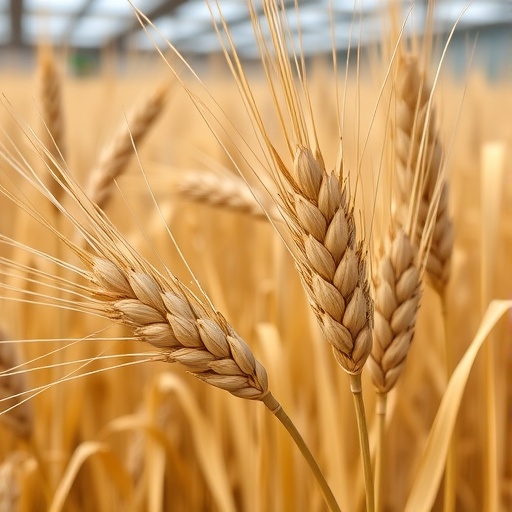In the intricate tapestry of agricultural science, research consistently aims to unearth the biological mechanisms that underpin crop resilience against pathogens. A recent study by Zhang, Li, Gao et al. ventures deep into the realm of wheat resistance to Fusarium crown rot, a devastating disease caused by Fusarium species. Their investigation not only sheds light on the phenotypic traits associated with resistant and susceptible germplasm but also delves into the realm of comparative transcriptomics, which underscores the molecular battles that wheat engages in against this pathogen.
Wheat, as one of the staple crops globally, is crucial for food security and agricultural sustainability. With Fusarium crown rot leading to substantial yield losses, understanding the genetic and molecular foundations of resistance has become imperative. The researchers deployed a multi-faceted approach, combining field observations with high-throughput transcriptomic analyses. This methodology warranted a comprehensive understanding of the biological processes that confer resistance or susceptibility to this disease.
The research team meticulously characterized the phenotypes of various wheat germplasm. By screening multiple strains under controlled conditions, they identified key observable traits that correlated with resistance to Fusarium crown rot. Traits such as root architecture, shoot development, and overall plant vigor were meticulously documented. This phase of research was essential, as it established a direct link between phenotypic expression and genetic predisposition toward disease resistance.
Moreover, the study plunged into the depths of comparative transcriptomics, allowing researchers to assess gene expression patterns across both resistant and susceptible wheat germplasm. By utilizing advanced sequencing technologies, they identified differentially expressed genes (DEGs) that played pivotal roles in the plant’s defense responses. These DEGs encompassed a variety of functional categories, from pathogen recognition to downstream signaling pathways that activate defense mechanisms.
In addition to identifying these genes, the researchers focused on the biological pathways involved in the defense against Fusarium. They uncovered that several resistant strains exhibited enhanced expression of genes associated with the production of phytohormones like salicylic acid and jasmonic acid, which are crucial for regulating plant immune responses. The interplay of these hormones orchestrates a complex signaling network that primes the plant for a robust defense against Fusarium attack.
The study highlighted the importance of timing and spatial expression of these defense-related genes. Successful resistance was often characterized by an early and sustained gene expression response upon pathogen challenge. This contrasts sharply with susceptible strains, which displayed delayed or inadequate gene activation. Understanding the timing of these responses could pave the way for developing markers that breeders could use in selecting resistant wheat varieties.
Equally revealing was the role of secondary metabolites in wheat’s defense arsenal. The researchers noted an upregulation of certain phenolic compounds in resistant germplasm, which are known for their antifungal properties. This finding not only adds another layer to our understanding of plant defenses but also suggests potential avenues for enhancing resistance through induced metabolic pathways.
As the research progressed, the authors acknowledged the overarching theme of host-pathogen interactions as a dance of adaptation and response. Fusarium’s ability to manipulate host physiology for its benefit was evident in the transcriptomic profiles of susceptible strains, revealing a troubling narrative of susceptibility. Understanding these machinations could inform new strategies for managing Fusarium crown rot in wheat through integrated pest management techniques.
Beyond the immediate implications for wheat breeding, the findings possess broader agricultural significance. The techniques employed in this research exemplify how modern genomic methodologies can unravel complex plant-pathogen interactions. By bridging the gap between phenotypic observation and genomic data, this work sets a precedent for future studies targeting resilience traits across different crops and diseases.
The researchers also emphasized the collaboration between various scientific disciplines, ranging from plant biology to bioinformatics, showcasing how multi-disciplinary approaches can drive innovation in crop science. This collaboration might inspire collaborative programs among institutions aimed at developing resilient crop varieties in the face of emerging pathogens, thus enhancing global food security.
In conclusion, Zhang et al.’s groundbreaking research not only elucidates the underlying mechanisms of wheat resistance to Fusarium crown rot but also provides a compelling roadmap for future exploration in plant pathology. By marrying phenotypic analyses with transcriptomic insights, they have set the stage for developing resilient wheat varieties that are critical in a world increasingly challenged by climate change and burgeoning pests and pathogens.
As the story of wheat and Fusarium continues to unfold, the implications of this research will resonate beyond academia, influencing agricultural practices, breeding programs, and ultimately the plates of consumers worldwide. This work is a testament to the power of scientific inquiry in addressing some of the most pressing challenges facing modern agriculture today.
Subject of Research: Resistance mechanisms of wheat to Fusarium crown rot
Article Title: Phenotypic and comparative transcriptomic analyses of resistant and susceptible germplasm reveal the putative resistance mechanisms of wheat to fusarium crown rot
Article References:
Zhang, M., Li, D., Gao, L. et al. Phenotypic and comparative transcriptomic analyses of resistant and susceptible germplasm reveal the putative resistance mechanisms of wheat to fusarium crown rot. BMC Genomics 26, 1020 (2025). https://doi.org/10.1186/s12864-025-12237-x
Image Credits: AI Generated
DOI: https://doi.org/10.1186/s12864-025-12237-x
Keywords: Wheat, Fusarium crown rot, phenotypic traits, comparative transcriptomics, gene expression, plant resistance mechanisms, agro-biology.
Tags: agricultural science researchagricultural sustainability and food securitycomparative transcriptomics in wheatcrop resilience against pathogensFusarium crown rot diseasegenetic foundations of wheat resistancehigh-throughput transcriptomic analysesmolecular mechanisms in plant disease resistancephenotypic traits of wheat germplasmplant vigor and disease resistancewheat resistance mechanismsyield losses due to Fusarium





